Vapor lock is a fuel delivery issue that arises when fuel vaporizes within the fuel lines, preventing the proper flow of liquid fuel to the engine. This disruption can lead to engine stalling or difficulty restarting, particularly during or after operating under high-temperature conditions. Vapor lock is most commonly observed in carbureted engines and older vehicles, as their fuel systems are more susceptible to heat-related complications.
Hot weather, combined with prolonged engine operation, creates ideal conditions for this issue to occur. Understanding how to stop vapor lock is crucial for maintaining engine performance and preventing unexpected breakdowns. This article will explore the causes of vapor lock, its telltale signs, and practical steps you can take to prevent or resolve this frustrating problem. Whether you’re a seasoned driver or new to vehicle maintenance, this guide will equip you with the knowledge to effectively address vapor lock.

What Is Vapor Lock?
Vapor lock is a condition that occurs when fuel in the fuel lines heats up to the point where it vaporizes, disrupting proper fuel flow to the engine. This issue arises due to high temperatures and low pressure in the fuel delivery system. When fuel turns into vapor, it creates air pockets within the fuel lines, which prevents liquid fuel from reaching the engine. Without adequate fuel flow, the engine may stall, lose power, or fail to start altogether.
It’s important to distinguish vapor lock from other fuel delivery problems, such as clogged fuel filters or failing fuel pumps. While these issues also impede fuel flow, they typically involve physical blockages or mechanical malfunctions rather than the phase change of fuel caused by heat.
Historically, vapor lock was a common issue in older vehicles equipped with mechanical fuel pumps, as these systems were more susceptible to the effects of heat. Modern vehicles, with their advanced fuel injection systems and pressurized fuel delivery, are far less prone to vapor lock. However, even newer vehicles can experience this issue under extreme conditions, making it essential for drivers to understand and address vapor lock effectively.
Symptoms of Vapor Lock
Vapor lock presents itself through a variety of symptoms that can hinder a vehicle’s performance, particularly in hot weather or under specific driving conditions.
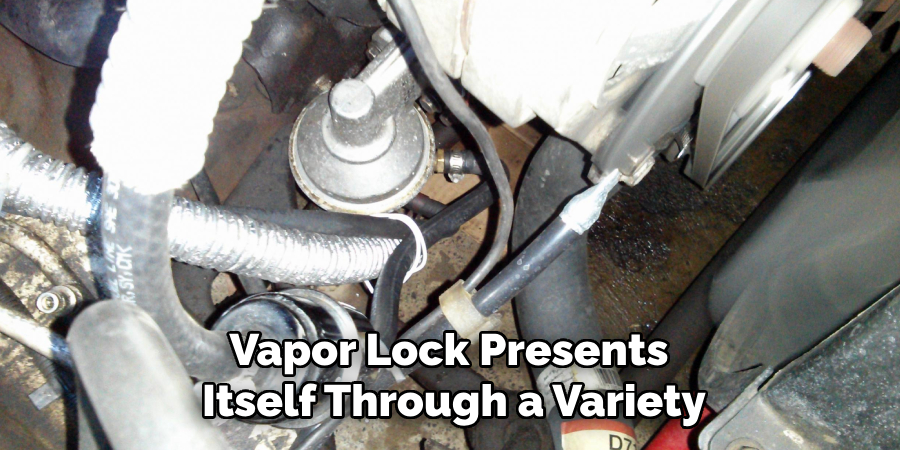
Engine Stalling
One of the most common signs of vapor lock is engine stalling. This can occur unexpectedly, especially after the vehicle has been idling for an extended period or after driving in high-temperature environments. The sudden loss of power can be alarming and dangerous.
Difficulty Starting
Drivers may experience hard starts after the engine has been running and then turned off for a short time. This symptom is often seen when attempting to restart a warm engine, as heat in the fuel lines exacerbates the issue.
Uneven Performance
Hesitation, sputtering, or misfiring are additional indicators of vapor lock. These issues result from fuel flow interruptions, disrupting the engine’s ability to operate smoothly.
Temperature-Triggered Issues
Symptoms of vapor lock tend to worsen as ambient temperatures rise. Driving uphill or under strained conditions can also intensify the problem, making the vehicle more susceptible to fuel vaporization and the associated complications. Understanding these signs can help drivers identify and address vapor lock before it escalates further.
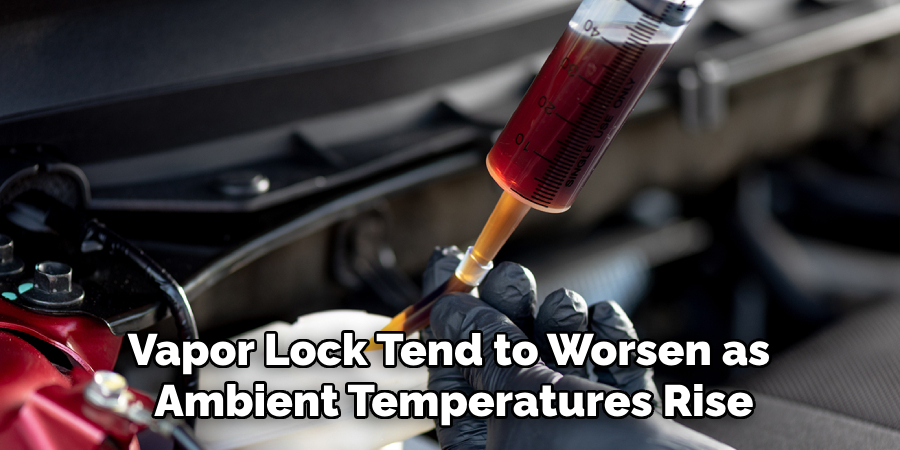
How to Stop Vapor Lock: Immediate Solutions to Vapor Lock
Addressing the vapor lock promptly is essential to restore proper engine function and prevent further complications. By implementing the following immediate solutions, drivers can effectively manage the issue:
Cool Down the Engine
The first step when encountering vapor lock is to cool the engine. Turn off the engine and allow it to rest for 20-30 minutes. During this time, open the hood to release trapped heat from the engine bay, expediting the cooling process. This step is particularly effective in reducing the temperature around the fuel lines, making it less likely for the fuel to vaporize.
Use Cold Water or Ice
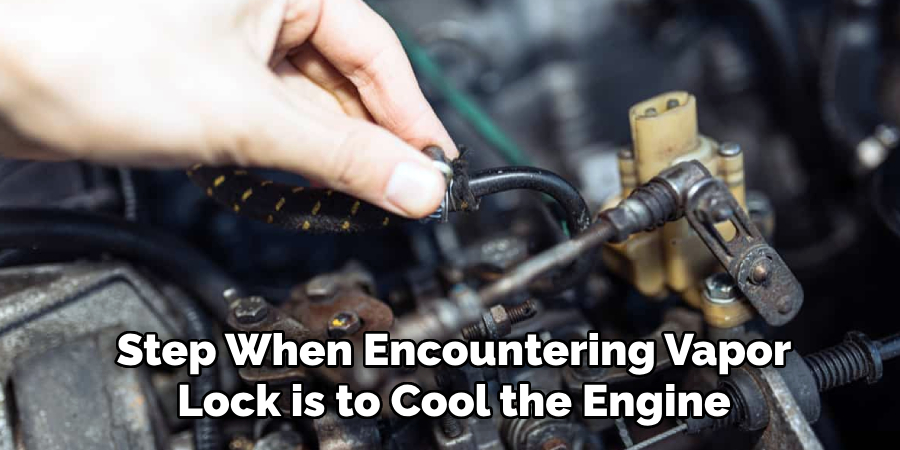
Applying cold water or ice directly to the affected fuel lines or the mechanical fuel pump can help condense the vaporized fuel back into liquid form. This technique rapidly lowers the temperature in the critical areas where vaporization occurs, allowing normal fuel flow to resume. When using this method, take caution to ensure sudden temperature changes do not damage the engine’s components.
Manually Pump the Accelerator
For vehicles equipped with carbureted fuel systems, manually pumping the gas pedal might assist in overcoming vapor lock. This action forces liquid fuel into the system, helping to push the vaporized pockets out of the fuel lines or pump. However, this solution depends on the vehicle type and its mechanical configuration, and it might not be effective for newer fuel-injected engines.
Start with the Throttle Open
If the engine fails to start due to vapor lock, pressing the accelerator pedal down while cranking the engine can help. This action increases airflow through the system, aiding in the dissipation of excess heat and promoting fuel movement through the lines. It’s important to ensure the engine is safe and that other systems function correctly before attempting this method.
By following these immediate measures, drivers can mitigate the effects of vapor lock and restore their vehicle’s operability. For recurring instances, addressing the root cause through permanent solutions, such as insulating fuel lines or installing an electric fuel pump, is recommended to avoid future disruptions.
Preventing Vapor Lock
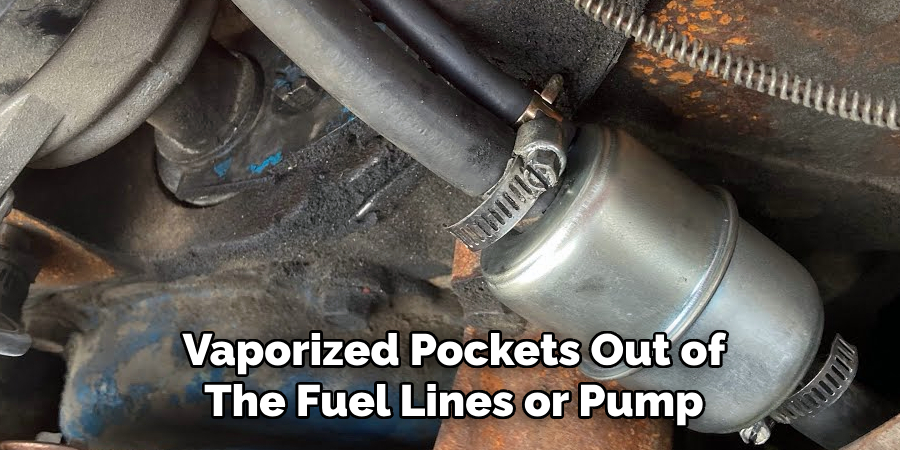
Preventing vapor lock ensures consistent vehicle performance, especially in high-temperature environments. Here are several effective strategies to minimize the risk:
Upgrade the Fuel Pump
Installing an electric fuel pump can help maintain consistent fuel pressure and temperature, reducing the chances of fuel vaporizing within the lines. Electric pumps are particularly effective as they operate independently of engine heat.
Relocate Fuel Lines
Positioning fuel lines away from heat sources, such as the exhaust manifold, can significantly lower the risk of vapor lock. Proper routing minimizes exposure to high temperatures and keeps the fuel stable.
Add Heat Shields
Installing insulation or heat shielding around the fuel lines provides additional protection. These barriers reflect or absorb heat, preventing it from reaching the fuel system.
Use High-Octane Fuel
High-octane fuels have a higher resistance to vaporization, making them less prone to causing vapor lock. This simple change can noticeably impact vehicle reliability in hot weather.
Avoid Ethanol-Blended Fuels
Ethanol-blended fuels have a lower boiling point, making them more likely to contribute to vapor lock. Opting for pure gasoline can help mitigate this issue and enhance overall fuel stability.
Diagnosing Vapor Lock
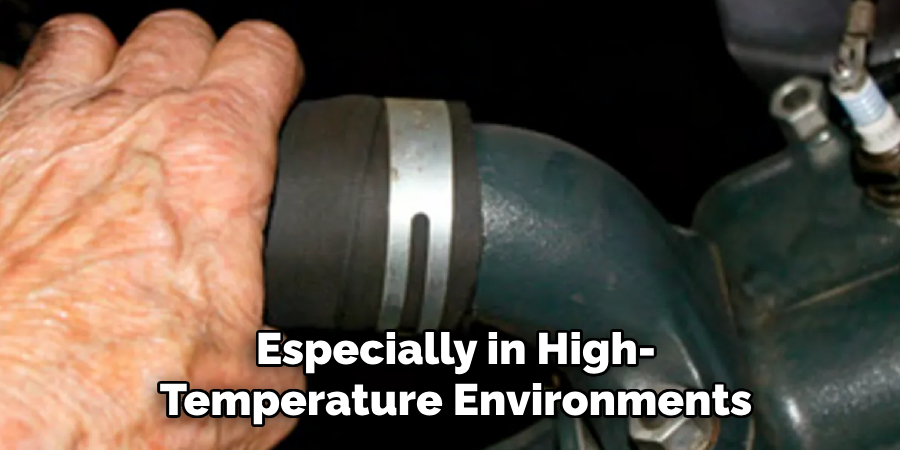
Diagnosing vapor lock requires a systematic approach to identify the issue accurately and ensure proper resolution.
Check Fuel Lines for Vapor Bubbles
Begin with a visual inspection of the fuel lines, especially if they are transparent or easily accessible. Look for signs of vapor bubbles, which indicate that fuel is not flowing properly and is transitioning to a gaseous state within the lines. This is a key indicator of a vapor lock occurring.
Test Fuel Pressure
A fuel pressure gauge measures the pressure within the fuel system. A significant drop in fuel pressure during operation could point to a vapor lock, as insufficient pressure may hinder fuel delivery to the engine. Monitoring pressure while the engine is running can provide useful insights into the condition of the fuel system.
Rule Out Other Issues
Before confirming the vapor lock, it is crucial to eliminate other potential causes, such as a clogged fuel filter or a failing fuel pump. These components can produce similar symptoms and should be checked thoroughly to ensure the root cause of the issue is addressed. By ruling out additional problems, you can confidently identify vapor lock as the culprit and take appropriate measures to resolve it.
Modern Solutions for Older Cars
Electric Fuel Pump Installation
Installing an electric fuel pump is one effective solution to combat vapor lock in older vehicles. Begin by selecting a suitable electric fuel pump that matches your vehicle’s specifications. Locate a safe spot near the fuel tank for the pump installation, as electric fuel pumps are more efficient at pushing fuel rather than pulling it. Mount the pump securely and connect it to the existing fuel lines. Next, wire the pump to the vehicle’s electrical system, ensuring proper grounding and a reliable power source. Test the pump for smooth operation before completing the installation. This method enhances fuel delivery consistency and minimizes the risk of vapor lock.
Fuel Line Modifications
Another effective measure is replacing standard rubber fuel lines with metal ones. Metal fuel lines are better at resisting heat absorption, which helps maintain a cooler fuel temperature even in high-heat conditions. Start by removing the old rubber lines, then carefully bend and install metal lines along the same route. Use clamps to secure the new lines and check for proper alignment to avoid undue connection stress.
Fuel Additives
Fuel additives designed to lower fuel vaporization can also be used as a preventive measure. These additives modify the fuel’s composition, increasing its resistance to vaporization under high-temperature conditions. Simply add the recommended amount of additive during refueling for optimal protection. Combined, these modern solutions can significantly reduce the risk of vapor lock.
Conclusion
Understanding how to stop vapor lock is essential for ensuring vehicle reliability and safety, especially in high-temperature conditions. By identifying the symptoms early and addressing them with measures like insulating fuel lines, upgrading the fuel pump, or using fuel additives, drivers can prevent this issue from disrupting their vehicle’s performance. Proactive modifications, such as replacing rubber fuel lines with metal ones, greatly reduce the risk of fuel vaporization. However, if the vapor lock persists despite these efforts, consulting a professional mechanic is highly recommended to diagnose and resolve the problem effectively. Taking these steps helps maintain smooth and safe operations.

